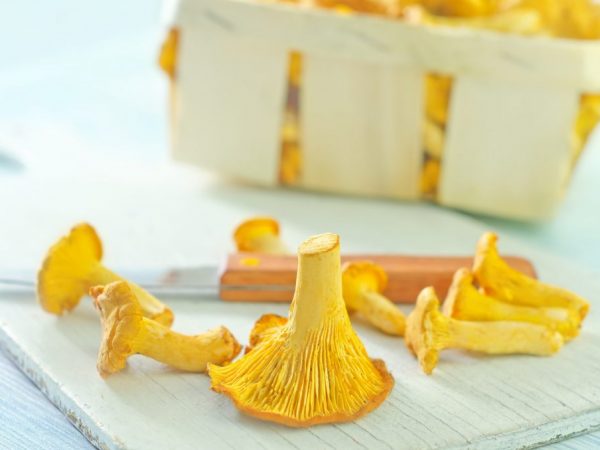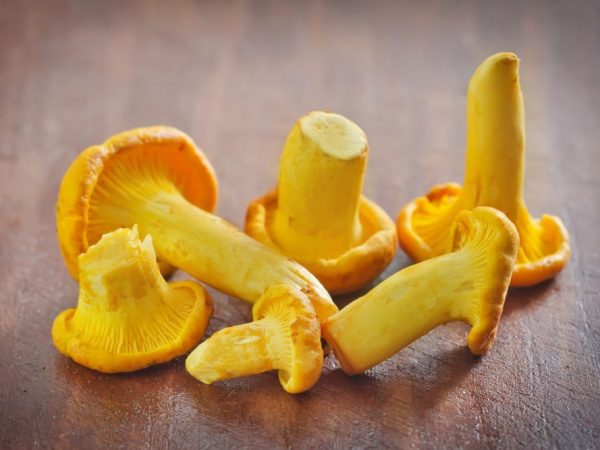Description of the tubular chanterelle
The tubular chanterelle, or Cantharellus tubaeformis, belongs to the class of agaricomycetes and is an edible species. Because of the characteristic cap, elongated in the shape of a funnel, mushroom pickers nicknamed the mushroom "funnel chanterelle"

Description of the tubular chanterelle
The appearance of the mushroom
The mushroom is tubular chanterelle, or tubular chanterelle, or funnel-shaped chanterelle, usually of medium size, yellow-brown color of the fruiting body. At the beginning of growth, it has an even or slightly convex cap, which, as it grows, becomes funnel-shaped and elongated. The diameter rarely even reaches 6 cm, the average size for this species is considered to be 2-4 cm. The entire cap is covered with thin veins, which are darker in color than the surface of the chanterelle itself. The edges of the cap look down.
- The pulp is elastic, easy to chew, has a pronounced mushroom taste and a pleasant aroma.
- The spore-bearing layer is gray in color, located on the back of the cap and outwardly looks like a set of veins directed towards the stem of the fungus.
- The leg is located in the center, has a cylindrical shape, its height is 4-7 cm, and its thickness is from 0.4 to 0.8 cm. The leg smoothly passes into the cap, the joint is dark.
Related species of mushroom
We habitually call mushrooms collected in forests by the appearance of their hymenophore tubular or lamellar. The chanterelle belongs to the lamellar representatives and does not have dangerous poisonous counterparts, with which it would be easy to confuse it.
Irina Selyutina (Biologist):
We are accustomed from school to the fact that mushrooms are divided according to the type of structure of the hymenophore into tubular and lamellar. In everyday life we use it this way and very often, looking at the lower part of the cap of the collected chanterelles, we wonder how it is a lamellar hymenophore, if the plates are thin, but in chanterelles, forgive "well-fed". So, the hymenophore of chanterelles in the world of biology is called folded, tk. indeed, instead of thin plates, it is represented by forked folds with blunt or even rounded edges. They are called pseudo- or false-plates. But it is on their surface that the spores necessary for the reproduction and settlement of chanterelles are formed.
The very same family Chanterelle, or Cantarella, is characterized by the presence of 5 genera, in which there are more than 90 species.
The tubular chanterelle is most similar to the following members of the family:
- Amethyst chanterelle: an edible mushroom, which has a large diameter of the cap (10 cm) and a leg that thickens up to 4 cm. The same funnel-shaped shape of the cap is preserved. This representative is found in all forests: deciduous, coniferous, mixed and herbaceous. Such mushrooms prefer to grow in colonies. Suitable for all types of workpieces.
- Common chanterelle: its main difference is the absence of a dark color at the junction of the leg and cap. There are no plates. Their place is taken by wavy folds or veins, the color of which coincides with the main color of the mushroom - light yellow. This species is distinguished by its inherent light fruity aroma. It will not be difficult to collect a large harvest, because.mushrooms never grow alone.
- Chanterelle black, or horn-shaped funnel: the main feature of this edible mushroom is its black color. The height reaches 10 cm, the diameter of the cap is 3-5 cm, its edges are strongly curved inward, the thickness of the leg is only 0.8-1 cm. The hymenophore is slightly wrinkled. This species is edible, however, when boiled, the pigment contained in the fruit bodies is released into the broth, making it black and can frighten those inexperienced in "dealing" with such mushrooms to cooks.
Beneficial features
Chitinmannose, ergosterol, trametonolinic acid and other polysaccharides contained in chanterelles are a good prevention of the appearance of worms. Ergosterol helps cleanse and restore liver function. This leads to the use of various extracts from this type of fungi in the treatment of hepatitis C and other liver diseases.
Tubular chanterelle is actively used in eastern countries for the manufacture of natural biologically active food supplements designed to fight parasites in the body. These drugs are most often produced in capsule form.
Contraindications

Pregnant women are prohibited from eating mushrooms.
The use of this type of food is prohibited:
- pregnant or lactating women;
- suffering from individual intolerance to the components that make up the mushrooms;
- the presence of gastrointestinal diseases - indigestion, disorder;
- having problems with the gallbladder;
- children under 3 years of age.
Attention! It is strictly forbidden to treat children (antihelminthic) with their use on their own.
Application
Due to its many useful properties, the tubular chanterelle has found application in cooking and medicine.
In cooking
Tubular chanterelle does not require pre-boiling. It is consumed fresh. So it retains all the beneficial properties and brings maximum benefit.
It is possible to use chanterelles for all types of workpieces and for cooking various dishes. They are pickled, fried and boiled, from this they do not become harder and do not lose their taste. But, heat treatment destroys all useful elements.
In medicine
The tubular chanterelle has not found its use in official medicine, but in some eastern countries it has established itself as an antihelminthic and hepatoprotective agent.
The effect is achieved due to the presence of a large amount of useful polysaccharides in the pulp. It is believed that regular consumption of chanterelles in food improves vision and prevents the appearance of inflammatory processes in the eyes, increases the resistance of immunity to infectious diseases.
Chanterelles are also used in cosmetology. The masks created on their basis have a good effect.
Irina Selyutina (Biologist):
You can make masks for hair and skin based on chanterelles at home, they will give you a feeling of youth.
- Rejuvenating mask: 2 tbsp. l. crushed (in a blender) fresh chanterelles, apply on the skin for 20 minutes. Then rinse off with warm water.
- Purifying and nourishing mask: 2 tbsp. tablespoons of fresh chopped (blender) chanterelles, 1.5 dessert spoons of sour cream, 3 tbsp. spoons of strong green tea, 2 tsp. oat flour, 2-3 drops of grape seed oil, mix and apply for 20 minutes on the face. Wash off with warm water.
However, before starting home cosmetic procedures, you need to find out if you have any allergic reactions to this product.
Homemade masks can help keep your skin looking youthful and your hair beautiful. Attention! When buying chanterelles on the market, you must be firmly sure that you have purchased real, and not false, chanterelles.
Conclusion
The tubular chanterelle is an excellent alternative to the common chanterelle and is free to eat: it does not require pretreatment. This species prefers to grow in colonies.It is actively used in the practice of oriental healers, because it contains a huge amount of useful elements, including polysaccharides, which help fight many problems.



